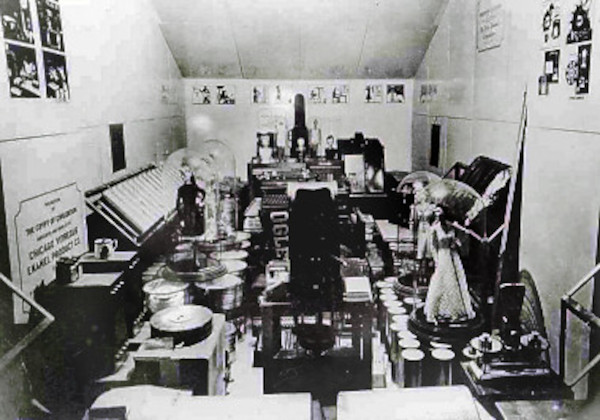Did you know there’s a 2000-cubic-foot airtight time capsule sealed in a basement at Oglethorpe University in Brookhaven, Georgia?
It’s called the Crypt of Civilization, and it won’t be opened until 8113 AD.
This might sound like something from a bad sci-fi movie, but it’s 100% real. Sealed in 1940 in the university’s old swimming pool, the time capsule was the brainchild of Dr. Thornwell Jacobs.
Described as “the father of modern time capsules,” Jacobs was Oglethorpe University President between 1915 and 1944. Incredulous at the lack of items and records from history, he formed an ambitious idea:
What if he could preserve for future generations a record of the 20th century and all human knowledge up to that point in time?
Enter the Crypt of Civilization, which the Guinness Book of Records has called “the first successful attempt to bury a record for any future inhabitants (of planet Earth).”
Find out more about it, including what’s inside, below.
The Origins of the Time Capsule
It’s the 1920s, and research for one of Jacobs’ books isn’t going well. He’s searching for detailed insights into ancient Egyptian life but struggling to find anything. He can’t believe it.
He realizes that basically everything humans knew up to that point about the Egyptians came from two rather incomplete sources.
First, they had whatever physical items had been uncovered in the tombs of ancient Pharaohs and kings. Second, they had inscriptions on rocks and tablets from ancient Assyria.
And that was it.
The implication was clear. How could one form a complete and accurate understanding of life in those times with such a limited pool of items and information? You could make educated inferences and gain a degree of understanding of past events. But that was about it.
The realization prompted the cogs inside Jacobs’ brain to start turning.
What if there was a way to ensure future generations didn’t have such a hard time? Could he create a tomb-like structure of his own, inside of which lay everything someone might need to understand the life and traditions of a) someone living in the 20th century and b) all who came before?

An Idea Becomes Reality
Jacobs pursued the idea, gathering help from Scientific American, a magazine that promised to promote the project, and from a scientist called Thomas Peters.
It took the best part of four years to turn into a reality.
Scientific American published an article detailing Jacobs’ concept in November 1936. By mid-1940, they’d gathered the full set of items they were using to represent 6000 years of human life.
As for the time capsule itself, Jacobs had a swimming pool at Oglethorpe University converted into an airtight chamber. It was 20 feet long, 10 feet high, and 10 feet wide.
It’s built right onto the bedrock and has a stone roof that’s 7 feet thick. The interior walls are lined with enamel. The door to the capsule is made of stainless steel, which was been welded shut. All the oxygen has been sucked from the chamber; they pumped inert nitrogen in its place.
If all goes well, it won’t be opened until 8113 AD. Why such a random number?
Because according to Jacobs’ calculations, it had been 6,177 years since the Egyptian calendar began. Thus, he decided it would be fitting if another 6,177 years passed before his capsule was opened.
What’s Inside the Crypt of Civilization?
Now for the interesting part. What did Jacobs decide to put inside his time capsule to represent 6000 years of scientific discovery and “modern” life on earth?
Here’s a sample of the crypt’s contents:
- Airtight canisters containing microfilms with over 800 books of literature, including the Christian Bible and the Quran
- Voice recordings of world leaders from the 1930s, including Hitler and Stalin
- Devices that would let future generations listen to those voice recordings
- Contemporary scientific tools, including something that would help teach English to future generations
- Glass jars with half-size models of people in 1930s clothing
- A manuscript of the movie Gone With the Wind
- Seed samples
- Electric toaster
- Dental floss
- Manual typewriter
- Electric radio
- A cash register from a store
- Children’s toys
- Artie Shaw records
- A woman’s purse
- Budweiser beer
- A mechanical pencil
- Fountain pen
- Can opener
Pictographs painted by George Carlson line the walls, portraying the history of human development and intelligence.
Jacobs even included a small windmill in the crypt that would create electricity to power electrical items stored inside.
With advice from the Bureau of Standards, Jacobs decided to store everything in a similar way to how items were found in ancient Egyptian tombs.
At a basic level, they were stacked on shelves and the floor. However, to prevent changing/breaking down over the millennia, many items were put in stainless steel holders. These containers were lined with glass and filled with an inert gas.
The time capsule was sealed on May 28, 1940. It’s set to be opened on May 28, 8113.
If you visit Phoebe Hearst Hall at Oglethorpe University in Atlanta, Georgia, you can go and see the sealed stainless steel door. On it, you’ll see a plaque that reads:
“This Crypt contains memorials of the civilization which existed in the United States and the world at large during the first half of the twentieth century”

